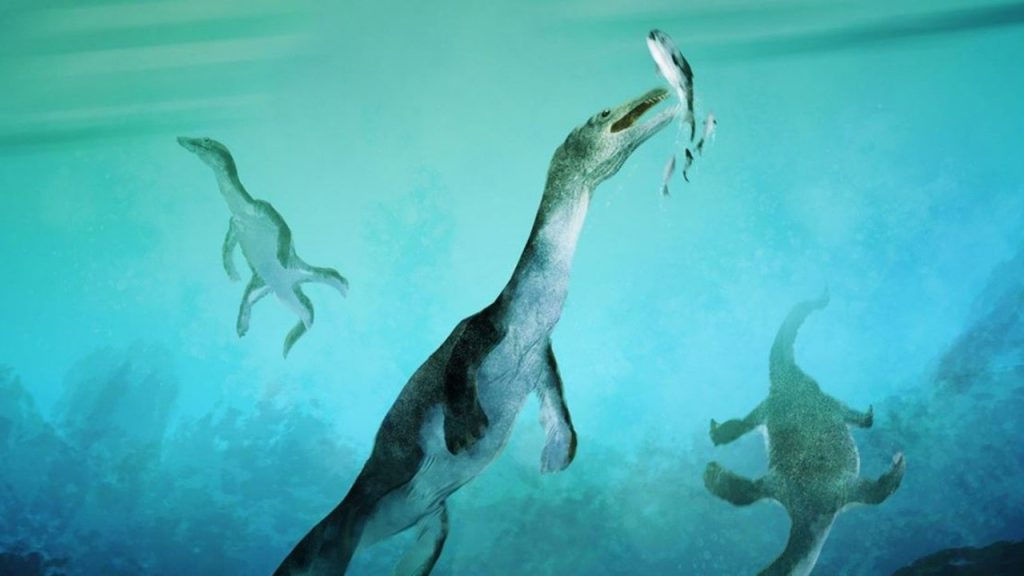A 246 million-year-old reptile fossil discovered in New Zealand has been identified as the oldest marine reptile fossil found in the Southern Hemisphere, according to a Swedish museum. The fossil belongs to a nothosaur, an extinct aquatic reptile that lived during the Triassic period at the dawn of the dinosaurs. Nothosaurs were predecessors of Plesiosaurs and had conical teeth for catching fish and squid. The fossil was first excavated from a boulder in 1978, but its significance was not recognized until recently, when paleontologists from various countries examined and analyzed it. The discovery has shed new light on the previously unknown record of early sea reptiles from the Southern Hemisphere.
The nothosaur fossil is more than 40 million years older than any previously discovered sauropterygian fossil in the Southern Hemisphere. This finding has completely upended scientists’ understanding of how nothosaurs swam from one end of the Earth to the other. The fossil indicates that these ancient sea reptiles lived in a shallow coastal environment within what was then the southern polar circle. Using a time-calibrated evolutionary model of sauropterygian global distributions, researchers have determined that nothosaurs originated near the equator and rapidly spread both northwards and southwards as marine ecosystems became re-established after a catastrophic mass extinction. This suggests that the ancient polar regions were a likely route for their earliest global migrations, similar to the trans-oceanic journeys undertaken by whales today. Researchers believe that more fossil remains of long-extinct sea monsters are waiting to be discovered in New Zealand and elsewhere in the Southern Hemisphere.
The fossil discovery in New Zealand has provided valuable insight into the evolution and distribution of ancient marine reptiles. Nothosaurs swam with four limbs and had conical teeth that allowed them to catch fish and squid. The fossil sheds light on the evolutionary history of these creatures and their adaptation to different environments. The discovery has allowed researchers to better understand how marine reptiles thrived in extreme global warming during the dawn of the age of dinosaurs, providing new information on their migration patterns and habitats. This research has expanded our knowledge of prehistoric marine life and the impact of major environmental changes on sea creatures during the Triassic period.
The study of the fossil has been a collaborative effort involving paleontologists from Sweden, Norway, New Zealand, Australia, and East Timor. This international team of experts has worked together to analyze and interpret the significance of the nothosaur fossil. The findings have been published by Uppsala University paleontologist Dr. Benjamin Kear, who is the lead author of the study. The research team’s efforts have helped to uncover new information about the early sea reptiles that inhabited the Southern Hemisphere millions of years ago. The discovery of the nothosaur fossil in New Zealand has opened up new research opportunities and has the potential to lead to further discoveries of ancient marine reptile fossils in the region.
The discovery of the nothosaur fossil in New Zealand has provided a rare glimpse into the evolutionary history of marine reptiles in the Southern Hemisphere. This finding has challenged existing theories about the migration patterns and distribution of ancient sea creatures during the Triassic period. The fossil is an important contribution to the field of paleontology and has the potential to enhance our understanding of prehistoric marine ecosystems and the impact of major environmental events on marine life. The international collaboration among researchers involved in the study highlights the importance of sharing expertise and resources to uncover new insights into the ancient past. Future research in New Zealand and other parts of the Southern Hemisphere may yield more discoveries of long-extinct sea monsters, further enriching our knowledge of Earth’s prehistoric oceans.


